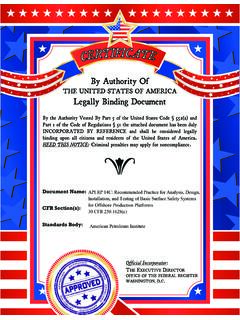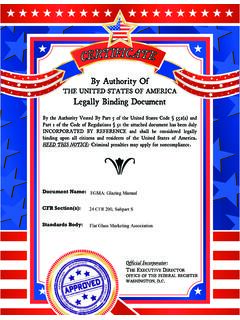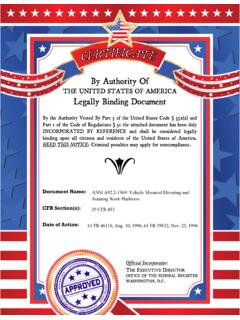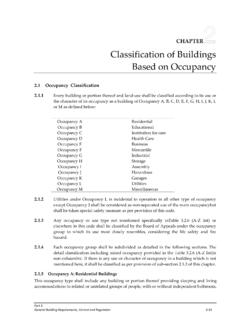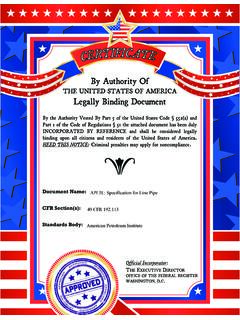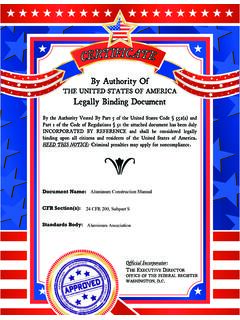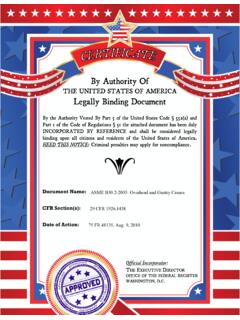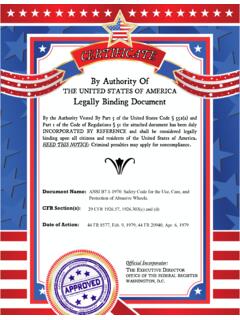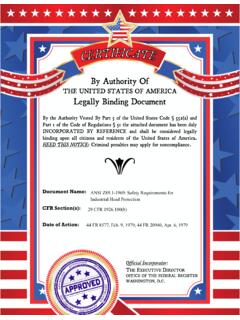Transcription of IS 14593 (1998): Design and construction of bored cast-in ...
1 Disclosure to Promote the Right To InformationWhereas the Parliament of India has set out to provide a practical regime of right to information for citizens to secure access to information under the control of public authorities, in order to promote transparency and accountability in the working of every public authority, and whereas the attached publication of the Bureau of Indian Standards is of particular interest to the public, particularly disadvantaged communities and those engaged in the pursuit of education and knowledge, the attached public safety standard is made available to promote the timely dissemination of this information in an accurate manner to the public. ! $ ' + - Satyanarayan Gangaram Pitroda Invent a New India Using Knowledge 0 1 ' 5 Jawaharlal Nehru Step Out From the Old to the New 1 + , 1 + Mazdoor Kisan Shakti Sangathan The Right to Information, The Right to Live !
2 > 0 B Bhart hari N ti atakam Knowledge is such a treasure which cannot be stolen Invent a New India Using Knowledge IS 14593 (1998): Design and construction of boredcast-in-situ piles founded on rocks - Guidelines [CED 48:Rock Mechanics]DESIGNANDCONSTRUCTIONOFBORED cast-in -SITU PILES FOUNDEDONROCKS- GUIDELINES ICS 0 BIS 1998 BUREAU OF INDIAN STANDARDS MANAK BHAVAN, 9 BAHADUR SHAH ZAFAR MARG NEW DELHI 110002 September 1998 Price Group 5 Rock Mechanics Sectional Committee, CED 48 FOREWORD This Indian Standard was adopted by the Bureau of Indian Standards, after the draft finalized by the Rock Mechanics Sectional Committee had been approved by the Civil Engineering Division Council. Pile foundations provide an effective means of transmitting large concentrated loads through overburden soils to underlying rock or socketed into rock.
3 bored cast-in -situ piles has the advantages of increasing the load carrying capacity by socketing the pile into rock. However the load transfer mechanism or distribution of load support of socketed pile is still in the development stage and depends upon the substrata condition and the type of rock modulus of rock, strength and unfavourable condition of rock. The rock material can vary from hard, fresh bed rock stronger than concrete, to highly weathered rock with properties of hard clay. Rock socketed piles derive their load carrying capacity from two components shearing resistance at the concrete-rock interface around the vertical cylindrical surface of the socket and end hearing resistance at the pile tip. There are several factors which control the load carrying capacity of rock socketed pile, like quality and strength of rock, efficiency of the load transfer mechanisms between the concrete pile and its rock socket.
4 construction of such rock socketed piles requires careful choice of method of construction including effective cleaning of the socket portion. As the techniques for measurements of the rock mass properties of foliated/jointed rock are not well developed, the mechanisms for side resistance and base resistance in rocks exhibif complex differences from those relevant to soils. Therefore, a separate standard covering bored cast-in -situ piles socketed into rock has been formulated for Design , construction , and interpretation of test results. The information from various international practices, designers, executing agencies, construction agencies being practiced in this country and the technical discussions thereon, including the available literature and considerable assistance from National Thermal Power Corporation Ltd have assisted in the preparation of this standard.
5 It has been decided to use the standard as guidelines initially, before adopting this standard as a code of practice. Technical Committee responsible for the formulation of this standard is given in Annex A. In reporting the result of a test or analysis made in accordance with this standard, if the final value, observed or calculated, is to be rounded off, it shall be done in accordance with IS 2 : 1960 Rules for rounding off numerical values (revised) . IS 14593 : 1998 Indian Standard Design AND construction OF bored cast-in -SITU PILES FOUNDED ON ROCKS - GUIDELINES 1 SCOPE This standard covers the Design of load bearing concrete bored cast-in -situ piles of diameter less than or equal to 1 500 mm which transmit the load of the structure to the rock through resistance developed either at the pile tip by end bearing or along the interface surface by pile rock adhesion or through both.
6 This standard does not cover well foundations . 2 RRFERRNCRS The Indian Standards given below contain provisions which through reference in this text, constitute provision of this standard. At the time of publication, the editions indicated were valid. All standards are subject to revision, and parties to agreements based on this standard are encouraged to investigate the possibility of applying the most recent editions of the standards indicated below: IS No. Title 456 : 1978 Code of practice for plain and rein- forced concrete (third revision) 1892 : 1979 Code of practice for subsurface investigation for foundation 2131 : 1981 Method of standard penetration test for soils (tier revision) 2809 : 1972 Glossary of terms and symbols relating to soil engineering 2911 Code of practice for Design and con- struction of pile foundations . (Part I/ Concrete piles see 1 to3): 1979 (Part 4) : 1985 465 1 (Part 4) : 1989 8009 (Part 1) : 1976 (Part 2) : 1980 11358 : 1987 Load test on piles (first revision) Code of practice for planning and Design of ports and h&ours: Part 4 General Design consideration (second revision) Code of practice for calculation of settlement of foundations : Shallow foundations subjected to symmetrical static vertical loads deep foundations subjected to symmetrical static vertical loading Glossary of terms and symbols relating to rock mechanics IS No.
7 Title 12070 : 1987 13063: 1991 Code of practice for Design and con- struction of shallow foundations on rocks Code of practice for structural safety of buildings on shallow foun- dation in rocks 3 TERMINOLOGY For the purpose of this standard, the definition of terms given in IS 2@l9 and IS 11358 shall be applicable in addition to the following. Rock Socket That portion of pile shaft which penetrates into a rot& formation beneath the overburden. 4 NECESSARY INFORMATION For the satisfactory Design and construction of bored cast-in -situ piles in rock, the following information is necessary : 3 b) cl 4 e) f) a) Information as per IS 2911 (Part l/Set 2). Geotechnical investigation data as laid down as per IS 1892, IS 13063 or any other relevant IS code. The rock profile, contours, the geological data and the necessary information as listed in IS 13063 along with the engineering and physical.
8 Properties of the rock strata/mass. Information of rock below the anticipated level of pile tip, generally not less than 5 m in bed-rock or more if otherwise. In case of bridge on pile foundations data on high flood level, maximum scouring depth, normal water level during working season, etc. In case of marine construction necessary infor- mation as per IS 465 1 (Part 4). Results of chemical tests to ascertain the chemical constituents like chlorides, sulphates, alkali and/or any other deleterious chemical content of soil/rock and ground water. 5 EQUIPMENT AND ACCESSORIES The equipment and accessories would depend upon the type of subsoil strata, ground water conditions, the 1 IS 14593 : 1998 type of rock/founding material and the required depth of embedment therein whichever applicable. Among the commonly used plants, tools and accessories, there exists a large variety of suitability on the subsoil and rock type conditions and manner of operations, etc.
9 Boring Boring operations are generally done by rotary or percussion type drilling rigs using direct mud circulation or reverse mud circulation methods to bring the cuttings out. Bailer and Chisel method if employed should be used with caution to avoid the effect of suction. Over cutting especially at the change of strata should be done with caution. Chiseling Chiseling may be resorted to in rock strata to penetrate up to required depth. Cutting Tool The size of the cutting tool should not be less than the diameter of the pile by more than 75 mm. Drilling Mud Use of drilling mud in stabilizing sides of boreholes is also made where appropriate or necessary. Drilling mud should satisfy the basic properties as defined in IS 2911 (Part l/Set 2). Cleaning Proper cleaning of piles after boring, after lowering the reinforcement and before concreting shall be done.
10 On completion of pile bore up to required depth, the bottom of pile bore shall be cleaned to remove rock debris, pile bore soil, etc. Rope operated grabbing or kelly mounted hydraulically operated grab can be used. Use of air lift technique is also effective in removing the rock debris. Liner Permanent liner may be used to avoid the aggressive action of ground water or otherwise. In case, liner is used and the pile bore is filled with water or drilling mud, the bottom part may be concreted using tremie so that the liner is effectively sealed against ingress of ground water, the upper part may be concreted in dry condition after inspection of the top surface of the concrete already placed. 6 Design CONSIDERATIONS General Pile foundations socketed in rock strata shall be designed in such a way that the load from the structure it supports, is transmitted to the rock without causing any rock failure and/or without causing such settlement (differential or total) under permanent/ transient loading as may result in structural damage and/or functional distress.
